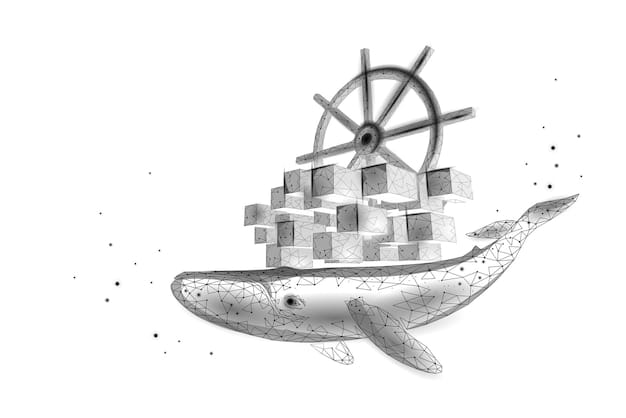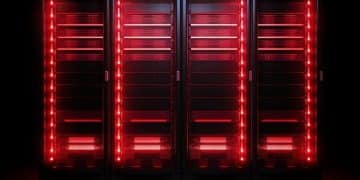Mastering Docker and Kubernetes: A 2025 Tutorial

Mastering Docker and Kubernetes in 2025 involves understanding containerization, orchestration, and deployment strategies through practical exercises, ensuring developers can efficiently manage and scale applications.
Dive into the world of containerization with this hands-on tutorial on Mastering Docker and Kubernetes: A Hands-On Tutorial for Containerizing Applications in 2025. Learn how to streamline your development process and deploy applications efficiently.
Understanding Docker for Containerization
Docker has revolutionized software deployment by allowing developers to package applications into containers. This ensures consistent performance across different environments. In this tutorial, we will cover the basics of Docker, including image creation and container management.
Docker simplifies the process of bundling an application with all its dependencies into a standardized unit. These units, called containers, can then be run on any system that supports Docker, ensuring consistency and portability.
What is Docker?
Docker is a platform that uses containerization to deliver software in packages. Containers isolate software from its environment and ensure that it works uniformly despite differences between development and staging.
Docker Images vs. Containers
A Docker image is a read-only template used to create containers. A container, on the other hand, is a runnable instance of an image. You can think of an image as a blueprint and a container as a house built from that blueprint.
- Images: Read-only templates that define the application and its dependencies.
- Containers: Runnable instances of images, providing an isolated environment for the application.
- Dockerfile: A script containing instructions to build a Docker image.

By leveraging Docker, developers can avoid the “it works on my machine” problem, ensuring applications behave consistently across different environments, reducing deployment issues.
Getting Started with Kubernetes
Kubernetes, often abbreviated as K8s, is an open-source container orchestration system that automates the deployment, scaling, and management of containerized applications. Understanding Kubernetes is vital for managing complex applications in 2025.
Kubernetes provides a framework to manage containers at scale. It handles tasks such as deploying applications, scaling them to meet demand, and managing updates and rollbacks.
Kubernetes Architecture
The architecture of Kubernetes consists of several components, including a control plane and worker nodes. The control plane manages the cluster, while worker nodes run the actual applications.
Key Kubernetes Components
Understanding the core components of Kubernetes is crucial for effective application management. These components work together to ensure the smooth operation of containerized applications.
- Pods: The smallest deployable units in Kubernetes, containing one or more containers.
- Deployments: Manage the desired state of your application, ensuring the correct number of replicas are running.
- Services: Provide a stable IP address and DNS name for accessing applications.
Kubernetes ensures high availability, scalability, and resilience for containerized applications by automatically managing and orchestrating containers across multiple nodes.
Setting Up a Docker and Kubernetes Environment
Before diving into practical examples, setting up a Docker and Kubernetes environment is essential. This involves installing Docker and a Kubernetes distribution like Minikube or Kind.
A well-configured environment allows for efficient development and testing of containerized applications. Setting up Docker and Kubernetes locally is the first step towards mastering Docker and Kubernetes: A Hands-On Tutorial for Containerizing Applications in 2025.
Installing Docker
Docker is available for various operating systems. Follow the official Docker documentation to install Docker Desktop on Windows or Mac, or Docker Engine on Linux.
Installing Minikube
Minikube is a lightweight Kubernetes distribution that allows you to run a single-node Kubernetes cluster locally, ideal for development and testing.
- Download Minikube: Download the appropriate binary for your operating system.
- Start Minikube: Use the `minikube start` command to start the cluster.
- Verify Installation: Use `kubectl get nodes` to ensure the cluster is running.

By setting up a local environment, developers can experiment with Docker and Kubernetes without impacting production systems, facilitating a safer and more efficient learning process.
Containerizing a Simple Application with Docker
To get hands-on experience, let’s containerize a simple application using Docker. This involves creating a Dockerfile, building an image, and running a container.
Containerizing an application ensures that it runs consistently across different environments. This is a fundamental step in mastering Docker and Kubernetes: A Hands-On Tutorial for Containerizing Applications in 2025.
Creating a Dockerfile
A Dockerfile is a script containing instructions to build a Docker image. It specifies the base image, dependencies, and commands to run.
Building and Running the Docker Image
Once the Dockerfile is created, you can build an image using the `docker build` command and run a container using the `docker run` command.
- Build Image: Use `docker build -t your-app .` to build the image.
- Run Container: Use `docker run -p 8080:80 your-app` to run the container.
- Verify: Access the application in your browser at `http://localhost:8080`.
By containerizing a simple application, developers gain practical experience in creating Dockerfiles, building images, and running containers, laying the groundwork for more complex deployments.
Deploying Applications to Kubernetes
Deploying applications to Kubernetes involves creating Kubernetes manifests (YAML files) that define the desired state of your application. These manifests specify the deployments, services, and other resources needed.
Kubernetes automates the process of deploying and managing applications at scale. This is a critical aspect of mastering Docker and Kubernetes: A Hands-On Tutorial for Containerizing Applications in 2025.
Creating Kubernetes Manifests
A Kubernetes manifest is a YAML file that describes the desired state of your application. It includes definitions for deployments, services, and other resources.
Applying Manifests to Kubernetes
Once the manifests are created, you can apply them to the Kubernetes cluster using the `kubectl apply` command. This creates the resources specified in the manifest.
- Create Deployment: Define the deployment in a YAML file.
- Create Service: Define the service to expose the application.
- Apply Manifests: Use `kubectl apply -f your-manifest.yaml` to apply the manifest.
Deploying applications to Kubernetes ensures that they are managed efficiently, scaled automatically, and updated seamlessly, enhancing application reliability and performance.
Advanced Kubernetes Concepts
To truly master Kubernetes, it’s essential to understand advanced concepts such as ConfigMaps, Secrets, and persistent volumes. These resources allow you to manage configuration data, secure sensitive information, and provide persistent storage for your applications.
Advanced Kubernetes concepts enable more sophisticated application deployments and management. These are essential components for mastering Docker and Kubernetes: A Hands-On Tutorial for Containerizing Applications in 2025.
ConfigMaps and Secrets
ConfigMaps are used to store non-sensitive configuration data, while Secrets are used to store sensitive information such as passwords and API keys.
Persistent Volumes
Persistent volumes provide persistent storage for your applications, ensuring data is preserved even if the container is restarted or deleted.
- ConfigMaps: Store configuration data separately from application code.
- Secrets: Securely store sensitive information.
- Persistent Volumes: Provide durable storage for your applications.
By understanding and utilizing these advanced concepts, developers can build more robust, secure, and scalable applications on Kubernetes.
| Key Point | Brief Description |
|---|---|
| 🐳 Docker Basics | Packaging apps into containers for consistent performance. |
| ⚙️ Kubernetes Setup | Setting up a local environment using Minikube. |
| 🚀 Deployment to Kubernetes | Using manifests to deploy applications. |
| 🔑 Advanced Concepts | Using ConfigMaps, Secrets, and Persistent Volumes. |
Frequently Asked Questions
▼
Docker ensures consistent application performance across different environments by packaging the application and its dependencies into a container, eliminating the “it works on my machine” problem.
▼
Kubernetes automates the deployment, scaling, and management of containerized applications, making it easier to handle complex deployments and ensuring high availability and resilience.
▼
Minikube is a lightweight Kubernetes distribution that allows developers to run a single-node Kubernetes cluster locally, ideal for development and testing without impacting production systems.
▼
ConfigMaps are used to store non-sensitive configuration data, while Secrets are used to store sensitive information such as passwords and API keys, providing a secure way to manage configuration.
▼
Persistent Volumes provide durable storage for applications, ensuring that data is preserved even if the container is restarted or deleted, allowing for more reliable and stateful application deployments.
Conclusion
Mastering Docker and Kubernetes: A Hands-On Tutorial for Containerizing Applications in 2025 involves understanding the fundamentals of containerization and orchestration. By following this tutorial, developers can gain practical experience in containerizing applications, deploying them to Kubernetes, and managing them effectively. The future of application deployment lies in mastering these technologies.





